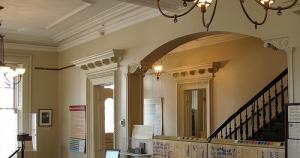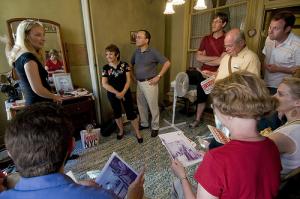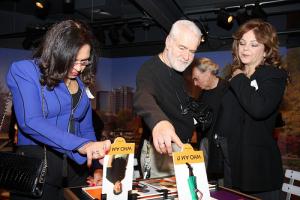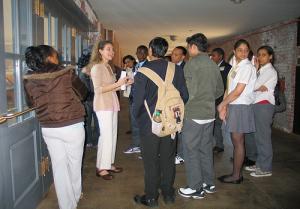
Thirteen museums across the country have joined forces to start a nation-wide conversation about immigration, past and present, in a national program called "Face to Face: Immigration Then and Now."
The program kicked off at the end of September in Chicago at the Jane Addams Hull House Museum, said Bix Gabriel, director of communications for the International Coalition of Sites of Conscience.
Each museum focuses on the history particular to the area in which it is located, Gabriel said. The International Coalition of Sites of Conscience has museums all over the world, such as the site of a former Jewish Ghetto located on the road to concentration camps in the Czech Republic.
"They’re very different types of histories. Not all of them are sites of tragedy, though many of them are,” Gabriel said.
 Here in America, the first museum to join the International Coalition of Sites of Conscience network for "Face-to-Face: Immigration Then and Now” was the Lower East Side Tenement Museum in New York City. The building features the restored apartments, which were homes to immigrants from the late 1800s to the 1900s. These apartments, Gabriel said, tell the stories of the immigrant experience during that time. The reaction is one of amazement, she said.
Here in America, the first museum to join the International Coalition of Sites of Conscience network for "Face-to-Face: Immigration Then and Now” was the Lower East Side Tenement Museum in New York City. The building features the restored apartments, which were homes to immigrants from the late 1800s to the 1900s. These apartments, Gabriel said, tell the stories of the immigrant experience during that time. The reaction is one of amazement, she said.
The history, Gabriel explained, points to issues and help people ask questions about the ways in which they think about immigration.
The conversation that International Coalition of Sites of Conscience encourages the public to have was a major selling point for Emily Zimmern, president of the Levine Museum of the New South in Charlotte, NC.
“Levine’s mission is post Civil War Southern history,” Zimmern said. “Since we were founded in 1991, we’ve always been committed to telling the stories of all who have shaped our region’s history and those making history in the South today. Our whole approach is to use history to build community and that we use history as a catalyst for civic engagement and dialogue.”
For the better part of the decade, the Levine Museum has been involved in a heavy internal discussion about how to combat the problem of the lack of interracial trust in the area. The conversation came about after the findings of a study released in which Charlotte, NC, ranked 39 out of 40 in the nation in terms of interracial trust, Zimmern said.
“We decided to pilot the notion of whether a museum exhibition could be effective in getting people talking in new ways,” she said. “It was professionally evaluated. We learned that it opened up people in ways they had never been before. We had comments like, ‘I’ve worked with you for 10 years, and I had no idea that was your story.’ We found that having an exhibit helped people approach tough issues that were harder if you directed them head on."
The Southeast, Zimmern explained, has experienced the highest rate of Latino growth in the country, drastically changing the cultural and ethnic landscape. The Brookings Institution, according to Zimmern has identified 12 hyper-Hispanic growth communities in the country, 10 of which are in the South and Charlotte being on the list.
 “This is all very different for our part of the country," Zimmern said. "For most of the 20th Century, the whole racial landscape was defined in terms of black and white.
“This is all very different for our part of the country," Zimmern said. "For most of the 20th Century, the whole racial landscape was defined in terms of black and white.
For most of the 20th Century, the South has had the fewest number of residents born outside of the U.S., and for the last 20 years that has changed dramatically. Today, Charlotte's residents have one in eight that are born outside the U.S.” However, being a place immigrants are attracted to is old hat for Cynthia Garrett, former superintendent for Ellis Island.
Garrett was instrumental in turning Ellis Island into a Site of Conscience, and said that Ellis Island represents the symbol of immigration in America.
“One of the amazing things about Ellis Island is that when you’re there, you can really imagine what the immigrants might have felt when they were arriving at Ellis Island,” Garrett said. “It makes people think about what it was like when they came to this country, wondering what it might have felt like when and if they would be allowed into the country. It brings history very much alive in a very personal way.”
 Garrett said the museum showed the history effectively, but what it failed to do before Ellis Island joined the Sites of Conscience network was connect the history with current events. Many of the hotly debated immigration issues people are grappling with today, were the same issues people were arguing over when immigration to Ellis Island was at its peak from the 1890s to the early 1950s, Garrett said.
Garrett said the museum showed the history effectively, but what it failed to do before Ellis Island joined the Sites of Conscience network was connect the history with current events. Many of the hotly debated immigration issues people are grappling with today, were the same issues people were arguing over when immigration to Ellis Island was at its peak from the 1890s to the early 1950s, Garrett said.
“The question of who should be allowed to come to America or who should be excluded is a consistent question throughout the history of immigration,” she said.
Henry Fernandez, a senior fellow at the Center for American Progress, researches how federal and local immigration policies affect towns, cities and counties, and says the conversation the program stimulates is a good thing.
"It is exciting that this network of immigration museums is going beyond sharing the history of immigration to America to invite people to draw connections between this history and today's immigrants — the struggles as well as similarities to all of us who call the United States home,” Fernandez said in a written statement. “This effort takes the debate out of the political shouting match and into a safe space where neighbors, some of whom are recent immigrants, some not, can talk openly and learn from each other. This has the real potential for transformative change."
For more information, please visite the International Coalition of Sites of Conscience.
Find an Immigration Sites of Conscience near you:
Angel Island State Park in Tiburon, Calif.
Angel Island Immigration Station Foundation in San Francisco
Arab American National Museum in Dearborn, Mich.
Cambodian American Heritage Museum, Chicago Cultural Alliance, Environment, Culture, and Conservation at the Field Museum and Jane Addams Hull-House Museum in Chicago
Japanese American National Museum in Los Angeles
Levine Museum of the New South in Charlotte, NC
Lowell National Historical Park & Tsongas Industrial History Center in Lowell, Mass.
Lower East Side Tenement Museum, Statue of Liberty National Monument and Ellis Island in New York
Save Ellis Island in New Jersey
New Americans Museum in San Diego, Calif.
University of Texas El Paso’s Paso al Norte Immigration History Museum in El Paso, Texas
Wing Luke Asian Museum in Seattle
~Photo Courtesy of Jane Addams Hull-House Museum
